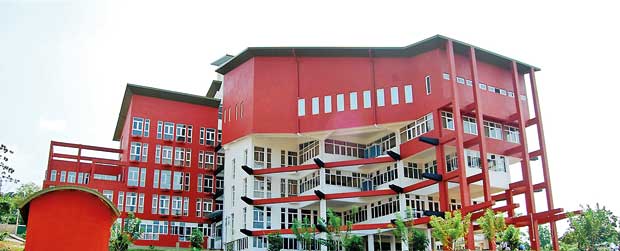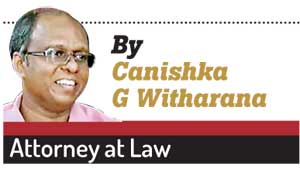Reply To:
Name - Reply Comment

No other authority/ institution, except the SLMC, is vested with statutory powers “to make regulations for the purpose of the maintenance of minimum standards of medical education
Authorities always focus on momentary suppression of the effect without treating the cause. SAITM has become a deteriorating menace. Time has come to provide a lasting and acceptable solution to this crisis before it goes beyond control. 
The Present is influenced and created by the Past. The first Educational Institute in the recorded history of Sri Lanka was ‘Mahaviharaya’ built in Mahamevuna by King Devanampiyathissa (236-276 B.C.). Its structure was carefully designed under the instructions of Arahath Mihindu, to meet specific standards as required at that time. Throughout the history these educational institutes, called Pirivenas and Moolayathanas, were headed by “Bhikkus” and developed with the patronage of Kings (State and authorities), intellectuals and scholars. They expanded their scope and curriculum to include medical education too. Both clergy and laity had equal access to education in these institutions. Highly advanced assessment and evaluation systems were practiced in these intuitions. The main objective of education was spir itual upliftment ( -Abayarathne Adikari (1991)).
On the other hand the State (King) was duty bound to maintain a freely available and accessible health service. Several books on Ayuvedic Medicine were written by our own doctors. ‘Saararthasangraha’ was one of the earliest written by King Buddadasa (398-426). Except those systems preserved in secret by several lines of generations, popular writings on medicine focused on maintaining one standard system throughout the history. ‘Vedahala’ (medical center/hospital) was an essential part of ancient cities (- History of Sinhalese Literature- Punchibandara Sannasgala (2013)).
Ancient governance was based on a social welfare system. Even today promotion of welfare of the people is a constitutional pledge of the State (Article 27). The basic concepts of early educational systems (though suppressed to some extent from 1505 onwards), were re-established by C.W.W. Kannangara, Minister of Education (1931-1947); the ‘father of free education’ in Sri Lanka.
"The basic concepts of early educational systems (though suppressed to some extent from 1505 onwards), were re-established by C.W.W. Kannangara"
Therefore for over two millennia, both health and education were rooted into the hearts of people of this country as systems providing free and equal access in the context of a welfare state. Their primary objective wasn’t profit, but service. The driving personalities of these systems, Buddhist monks, teachers and doctors (vedamahattayas) essentially sustained high levels in intellectual, personal and professional standards to maintain recognition and respect. In short, Sri Lankans were historically, psychologically and culturally molded to demand high standards in education and health systems. Medical-Education is a combination of both these systems.
The historical expectations of the people pertaining to quality, standards and to have free and equal access to Medical education and health service system were entrusted by the parliament to the Sri Lanka Medical Council (SLMC). It was incorporated by the Medical Ordinance, No 27 of 1927. It is mandatory under this law to register with SLMC, to practice as a Doctor (medical practitioner) in Sri Lanka. No other authority/ institution, except the SLMC, is vested with statutory powers “to make regulations for the purpose of the maintenance of minimum standards of medical education including standards relating to courses of study, examinations, staff equipment, accommodation, training and other facilities at the universities and other institutions which grant or confer any qualification which entitles a person to obtain registration” (Section 19(e)). This body functioned smoothly and maintained standards, respectable and free systems of Medical-Education and Health service, with equal rights of access.
Private Medical Education coupled with their prime objective of making profits was artificially planted in our soil as a system alien to our people. SAITM didn’t realize this hostile nature when introducing itself as a Private institute to provide Medical-education. So it embarked on an arrogant course of action. When people realized its substandard education and dishonest behavior, the situation worsened. SAITM seems to have believed that political backing and legal clearance alone would save it from this crisis. SAITM became totally blind to the reality that social acceptance was essential for its due recognition and survival.
From the very inception SAITM disregarded the requirement to obtain the recognition of the Sri Lanka Medical Council, the sole statutory (professional) body created by law, to monitor standards of medical practitioners and education. It published advertisements pretending it had affiliations with a State University in Russia; but failed to prove it when investigated by the Ministry of Health. GMOA, the largest union of Doctors called it a fake institution. It had no recognition as a higher educational institution competent of providing medical education when it started to register students for a medical course in 2009. By then it was a Technical and management institute. No authority monitored its standards. Later a hospital was built, but registered its name as a private company with the words ‘teaching hospital’ as part of its name. The reality is that such a hospital is not recognized by the Ministry of Health as a ‘teaching hospital’. That name is deceptive. In 2016 Deans of eight medical faculties in State Universities published an adverse report on SAITM stating, inter alia, that “there were many irregularities, if not outright deception of the public, in the manner in which the SAITM medical degree programme was established.” Since, SAITM could not maintain its position as an institute affiliated to a Russian University, it looked to the minister of higher education for recognition. The Minister, in spite of massive public protest, gave SAITM the recognition (by publishing in the Gazette) of a ‘degree awarding institute’. The Minister of Higher Education has powers to do such recognition after calling for reports from experts on standards of the institute. Very strangely the Gazette (No.1721/19 of 2011.08.30) contained several conditions. It is still questionable whether conditional recognition is valid under law. Inanity of this recognition could well be understood by understanding the nature of such conditions; some of these were; to ensure the establishment within six months (i) lecture theaters, (ii) auditoriums and examination halls, (iii) libraries (iv) tutorial rooms, (v) laboratories (vi) own teaching hospital and professional units etc. The level of competency of this ‘institute’ which hasn’t even “libraries, laboratories, auditorium rooms” etc. is questionable. This gazette was published in 2011, but by that time students had already been reading for the MBBS degree for two years (without even a library)!
"What and for whom a solution should be provided? When the past behavior is considered, the management of SAITM doesn’t deserve anything in their favor. However the government is responsible for not taking prompt action earlier."
In 2013 by Gazette No. 1829/36 of 2013.09.26, the Minister of Higher Education backdated the degree awarding status given to SAITM to cover all the students registered from 2009 onwards. This was also a conditional recognition. One of these conditions directs SAITM to “Execute a Deed of Trust and transfer 51% of the shares of SAITM to a Trust in terms of the provisions of such Deed within six months from 26.09.2013”. Whether a Trust was created is still unknown. Apart from that, it was required to “improve library facilities by providing necessary text books and journals relevant to the MBBS degree programme within six months from 26.09.2013.” Strangely, SAITM survived without even a proper library for four (4) years!
There is no evidence of any expert report as had been called for by the Minister of Higher Education to satisfy whether these conditions were fulfilled. Is SAITM still without a standard library? Can we think of SAITM as complied with other serious conditions relating to laboratories, clinical training, auditoriums etc.? SAITM has also neglected and failed to obtain a “compliance certificate” (from the SLMC) though it is mandatory in terms of rules made under the Universities Act. Therefore there is justification behind allegations on competency, quality and standards of SAITM.
In 2015 the SLMC conducted an inspection under section 19A of the Medical Ordinance with the participation of 10 professionals. Three main deficiencies were identified in the report; i.e.’- (i) General inadequacy of clinical exposure in all areas (ii) Lack of facilities for training in practical clinical Forensic Medicine (iii) Deficiency in exposure to preventive care services in the state sector. The final conclusion of the team is ... “that the SLMC does not recognize graduates who have completed the study programme currently provided by the Faculty of Medicine SAITM, as suitable for provisional registration”.
In such a context SLMC refused to grant provisional registration to a student possessing a MBBS-SAITM certificate. Her case filed in the Court of Appeal decided that SLMC had no provision to refuse registration. Presently this case is under appeal in the Supreme Court.
Today the crisis for SAITM has started to come from within; several parents of SAITM students objected to the conducting of MBBS exams without proper clinical training. The Government has recently issued a policy statement suspending further registration of students to SAITM. Several doctors, state university students, professionals and people demand for its immediate closure. SAITM has taken the country to a clash between two completely different systems. Forcible attempts of the executive to merge them, is impossible.
What and for whom a solution should be provided? When the past behavior is considered, the management of SAITM doesn’t deserve anything in their favor. However the government is responsible for not taking prompt action earlier. Therefore, the State’s responsibility to fulfill legitimate expectations of the students registered with SAITM, remains intact. SLMC should formulate a special program/course structure to elevate the standards of these students. A mechanism to absorb SAITM students into the profession may be made by SLMC.
In the midst of opposition SAITM students wouldn’t be able to obtain a degree from a State University. On the other hand, clinical training in state hospitals is essential for the Degree. State health sector belongs to a different discipline/system as said earlier. As the two systems are merging with each other, the only solution is to bring SAITM into the same system of State Health Service. This could only be done by ‘nationalizing’ SAITM, which is the only method that the people of this county have confidence in as capable of equating the foresaid differences. Any other mechanism wouldn’t be acceptable to both sides in the present context.